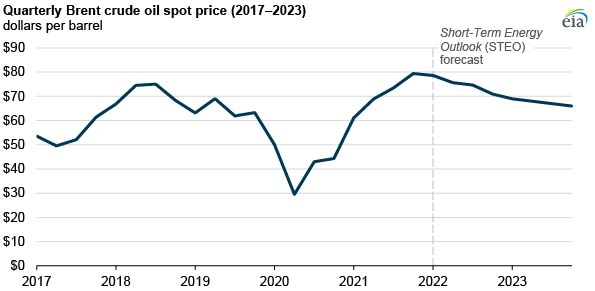EIA forecasts crude oil prices will fall in 2022 and 2023
Jan 12, 2022
In our January 2022 Short-Term Energy Outlook (STEO), we forecast that crude oil prices will fall from 2021 levels. In the fourth quarter of 2021, the price of Brent crude oil, the international pricing benchmark, averaged $79 per barrel (b). We forecast that the price of Brent will average $75/b in 2022 and $68/b in 2023.
The declining prices are driven by a shift from global petroleum inventory declines during 2021 to inventory increases in 2022 and 2023. Global petroleum inventories decline when consumption is greater than production and increase when production is greater than consumption.
In 2021, withdrawals from global petroleum inventories averaged 1.4 million barrels per day (b/d) and contributed to higher crude oil prices. These inventory draws resulted from petroleum consumption returning faster than petroleum production after the COVID-19 pandemic began in 2020. In 2022, we expect that petroleum production will increase and consumption growth will slow, leading to increases in petroleum inventories globally.
We expect global petroleum production will increase by 5.5 million b/d in 2022, driven by production increases in the United States, OPEC, and Russia, which together account for 84%, or 4.6 million b/d, of the growth. We forecast increased tight oil production in the United States and gradually increasing crude oil production from OPEC+ (which includes OPEC members and Russia) will account for most of the increased crude oil production.
We forecast that global petroleum consumption will increase by 3.6 million b/d in 2022, driven by more consumption in the United States and China, which together account for 39% of the consumption growth. We forecast that global petroleum inventories will increase by 0.5 million b/d in 2022, which will put downward pressure on crude oil prices. We forecast that the price of Brent crude oil in 2022 will fall from $79/b in the first quarter to $71/b in the fourth quarter.

In 2023, we expect continued inventory growth, averaging 0.6 million b/d. We forecast that global petroleum production will increase by 1.8 million b/d in 2023 from 2022, averaging 102.8 million b/d. In 2023, most of the growth in global petroleum production comes from producers in the United States and Russia. Production in the United States is forecast to increase by 0.8 million b/d, and production in Russia is forecast to increase by 0.3 million b/d. We forecast that OPEC production will increase by 0.1 million b/d in 2023.
We forecast global petroleum consumption in 2023 will increase by 1.8 million b/d. Like in 2022, the growth is largely driven by rising consumption in the United States and China, which we forecast will account for 43% of the consumption growth in 2023. India's petroleum consumption growth accounts for another 14% of the global total.
Similar Stories

Glander International Bunkering develops compliance calculator to address FuelEU Maritime
View ArticleCleantech Group honors outstanding innovators recognizing companies of the year, early-stage company of the year, rising stars of the year
8 innovators recognized for exceptional achievements
View Article
Daher renews its partnership with ITER to tackle logistics challenges of the world’s largest scientific project for sustainable energy
View Article
Forecast wholesale power prices and retail electricity prices rise modestly in 2025
View Article
Commerce celebrates groundbreaking of $1.2 billion lithium refinery in Muskogee
View ArticleShell completes acquisition of combined-cycle power plant in priority U.S. trading market
This acquisition maintains SENA’s position in the deregulated Independent System Operator New England (ISO New England) power market, securing long-term supply and capacity offtake for Shell. In the coming decades,…
View ArticleGet the most up-to-date trending news!
SubscribeIndustry updates and weekly newsletter direct to your inbox!





